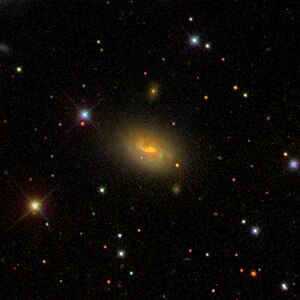NGC 2388
| Galaxy NGC 2388 |
|
|---|---|

|
|
| SDSS recording | |
| AladinLite | |
| Constellation | Twins |
|
Position equinox : J2000.0 , epoch : J2000.0 |
|
| Right ascension | 07 h 28 m 53.4 s |
| declination | + 33 ° 49 ′ 09 ″ |
| Appearance | |
| Morphological type | S / LIRG / HII |
| Brightness (visual) | 13.9 likes |
| Brightness (B-band) | 14.7 mag |
| Angular expansion | 1 ′ × 0.6 ′ |
| Position angle | 65 ° |
| Surface brightness | 13.2 mag / arcmin² |
| Physical data | |
| Redshift | 0.013790 +/- 0.000017 |
| Radial velocity | 4134 +/- 5 km / s |
|
Stroke distance v rad / H 0 |
(184 ± 13) x 10 6 ly (56.3 ± 3.9) Mpc |
| history | |
| discovery | William Herschel |
| Discovery date | February 4, 1793 |
| Catalog names | |
| NGC 2388 • UGC 3870 • PGC 21099 • CGCG 177-022 • MCG + 06-17-010 • IRAS 07256 + 3355 • 2MASX J07285341 + 3349084 • GC 1530 • H III 901 • h 448 • LDCE 0504 NED006 | |
NGC 2388 is an active spiral galaxy with extended star formation from the Hubble type S in the constellation of twins on the ecliptic . It is estimated to be 184 million light years from the Milky Way and about 55,000 ly in diameter.
It is likely gravitationally tied to NGC 2389 . In the same area of the sky are u. a. the galaxies NGC 2379 , NGC 2385 , NGC 2393 .
The object was discovered on February 4, 1793 by the astronomer William Herschel .
Web links
Commons : NGC 2388 - collection of images, videos, and audio files
